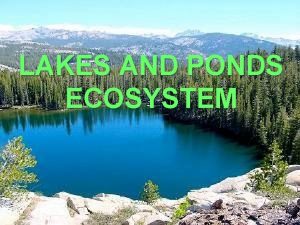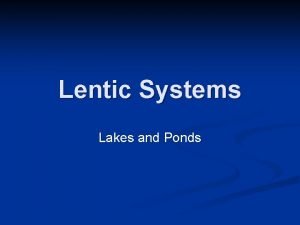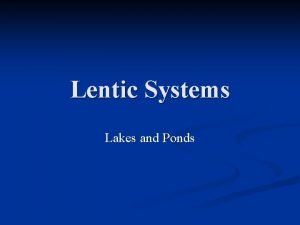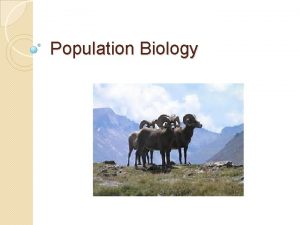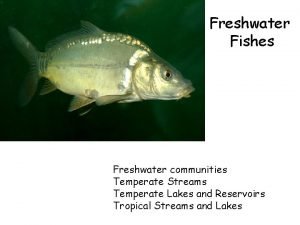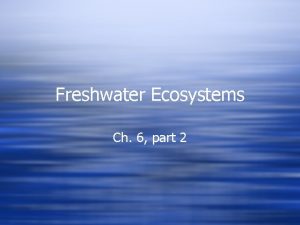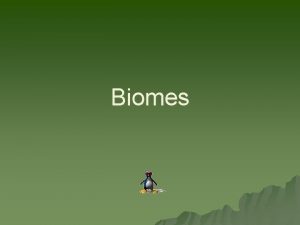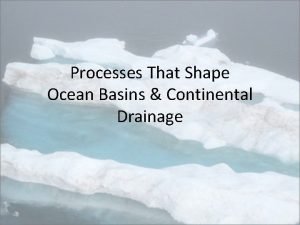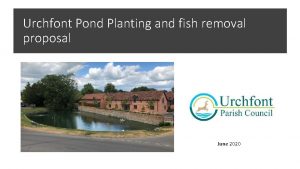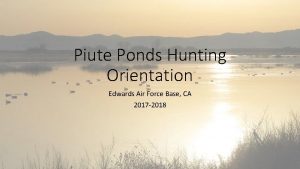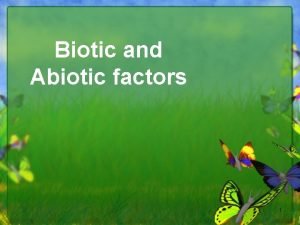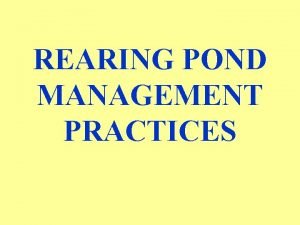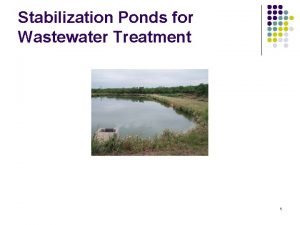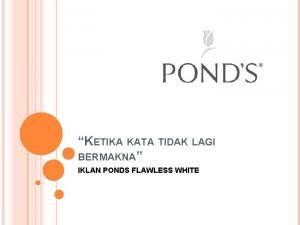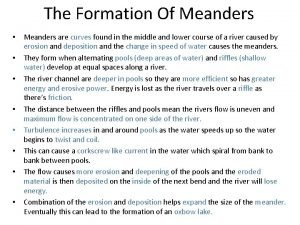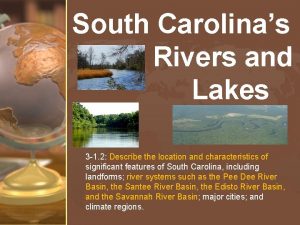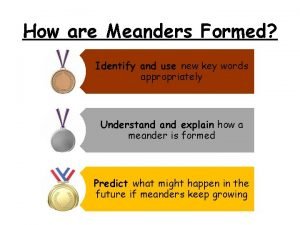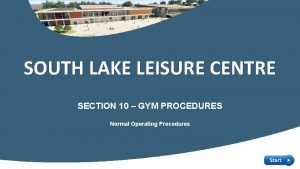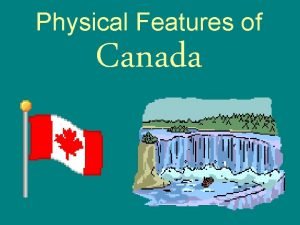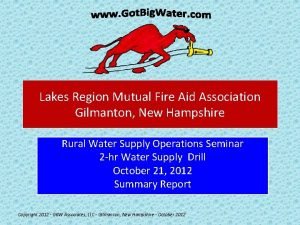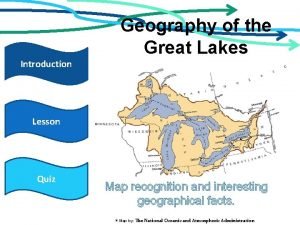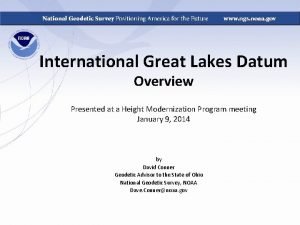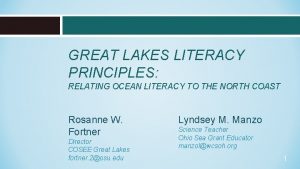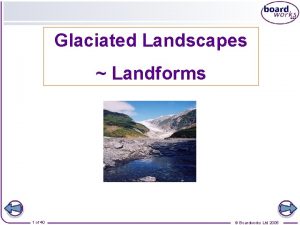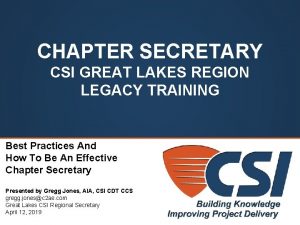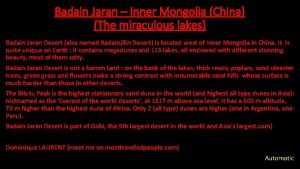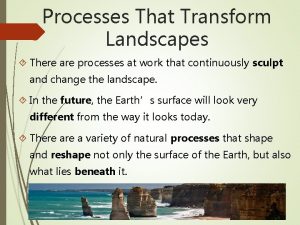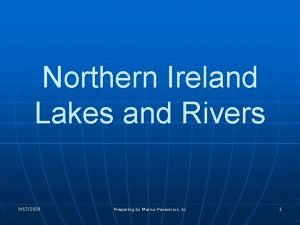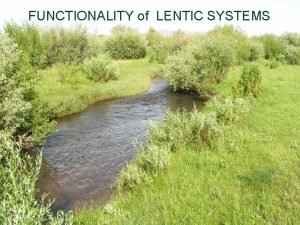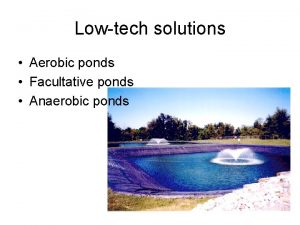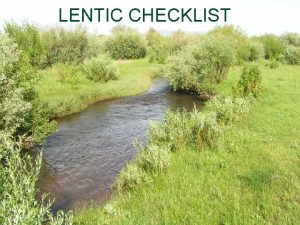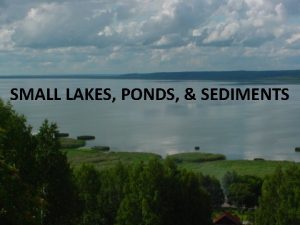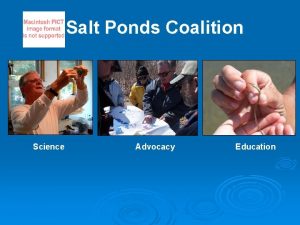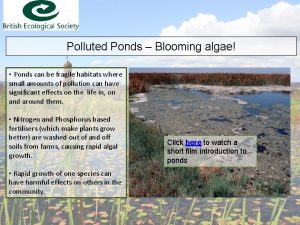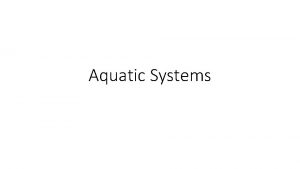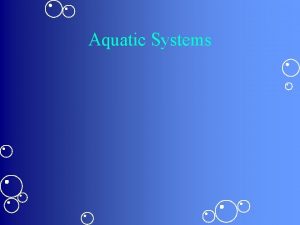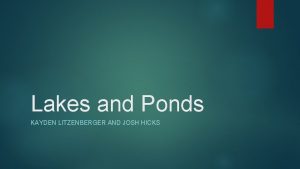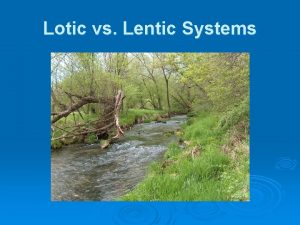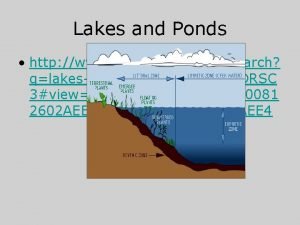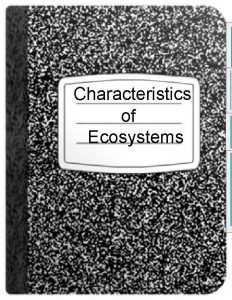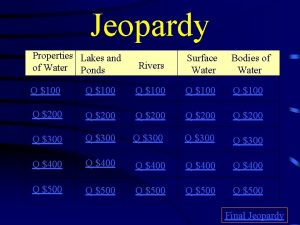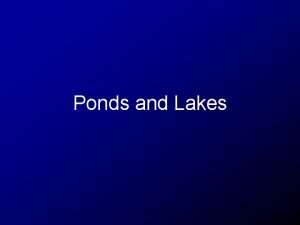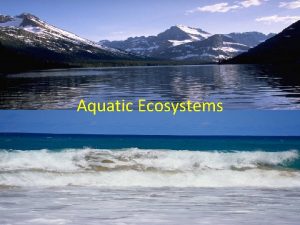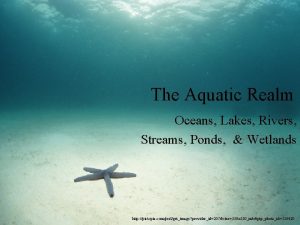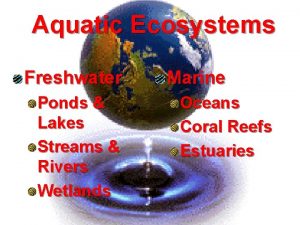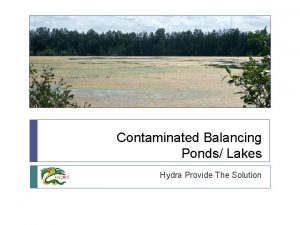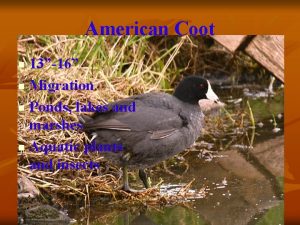Lentic Systems Lakes and Ponds Formation of Lakes
















































- Slides: 48

Lentic Systems Lakes and Ponds

Formation of Lakes Glacier lakes n Oxbow lakes n Playas n Man-made lakes n

Glacier Lakes Carved out by glaciers (glaciation), which fill with water n Northern U. S. and Canada n

How Does Glaciation Work? n n n As the glaciers move they act as scouring pads on the ground underneath them. Near the end of the last glacial period, roughly 10, 000 years ago, glaciers began to retreat A retreating glacier often left behind large deposits of ice in hollows between hills which later melted to create lakes. n n Rocks are eroded and mineral deposits become sediments at the bottom of the lake Some suspended minerals are used by algae for growth, making the water appear green

The Great Lakes in northern U. S. are the largest glacial lakes in the world.

The Seven Rila Lakes in Rila, Bulgaria Lake Jokulsarlon, in Iceland.

Oxbow Lakes Formed by meandering rivers n Loops of river gets cut off n Lakes are long and narrow, and usually U-shaped n Common in low valleys and flat coastal areas n

Oxbow Lake n An oxbow in the making: meanders and sandbank deposition on the Nowitna River, Alaska

How Does an Oxbow Lake Form? (1) On the inside of the loop, the river travels more slowly leading to deposition of silt.

(2) Meanwhile water on the outside edges tends to flow faster, which erodes the banks making the meander even wider. (3) Over time the loop of the meander widens until the neck vanishes altogether.

(4) Then the meander is removed from the river's current and the horseshoe shaped oxbow lake is formed. -- Without a current to move the water along, sediment builds up along the banks and fills in the lake.

Oxbow Lake n Oxbow lake and the Chippewa River in Eau Claire, Wisconsin.

Playas n Formed from multiple things that leave a depression n Soil erosion, wind, animal herds Small, shallow, and circular n Common in dry plains areas n These lakes are ephemeral, and only form at certain times of the year n

Playas are important habitat for migratory birds and waterfowl. n The Red-winged Blackbird, Blue-winged Teal, and the Mallard can all be found in playa lakes at some time of the year. n

n Sandhill cranes winter in playa lakes

Playa lakes in Kansas agricultural area

Man-Made Lakes n Water reservoirs formed from Damming rivers n Old rock quarries or mines n Stock ponds on farms and ranches n Lake Mead is formed as a result of damming the Colorado River by the Hoover Dam in Nevada

Zipingpu Dam on the Min River in China

Lentic Habitats n Characterized by The shoreline n The sides of the basin n The surface of the water n The bottom sediments n

Zones of Lentic Habitats Littoral zone n Limnetic zone n Profundal zone n

Littoral Zone Along shore where light can penetrate to the bottom n Rooted plants can grow n Shores have coarse sediments from action of waves n Sheltered areas have finer sediments (silt and clay) – plant growth in this zone n Animal life includes n n Invertebrates common to lotic habitats


Limnetic Zone Upper open water area of a pond or lake n Lack of rooted plants because light can’t penetrate the bottom n Plankton and fish are common n

Profundal Zone n Deep, bottom-water area n No light penetration n No photosynthetic organisms or rooted plants n Sediments are silt and clay mixed with organic matter that settles to the bottom n Organisms living here are tolerant of little or no light or oxygen.


Biological Productivity The amount of plankton, algae, aquatic macroinvertebrates and fish that a body of water can produce and sustain n Usually limited to the depth of light penetration n n Light penetration is limited by color of the water and amount of suspended solids

Ponds vs. Lakes n Pond = body of water where light penetrates all the way to the bottom n Lake = depth of light penetration varies from several inches to several feet

Determining the Trophic State n Total Plant Nutrients Phosphorous and nitrogen are needed for plant growth and maintenance n Certain level is needed (too much or too little is not a good thing) n If nutrients are too high, algae blooms occur n n Increase the turbidity of the water n Decrease the oxygen levels

n Chlorophyll A Measure of the algae population n Influenced by the amount of nutrients n n Water Clarity (turbidity) Water clarity determines how far light can penetrate n Phytoplankton and plants need light to grow, so they won’t grow if light is limited n Algae blooms cause lower water clarity n

Characteristics of Biological Productivity n 4 categories of lake classification based on biological productivity Oligotrophic n Mesotrophic n Eutrophic n hypereutrophic n

Oligotrophic Lakes Nutrient level and productivity is low n Water is clear n Low aquatic plants and plankton n Few fish n Sandy bottoms with little organic material n


Mesotrophic Lakes Nutrients and productivity is moderate n Some aquatic plants n Water clarity is becoming somewhat cloudy n

n Littoral habitat in a mesotrophic lake

Eutrophic Lakes Nutrient level and productivity is high n Large populations of algae, plankton, fish, plants, and macroinvertebrates n Frequent plankton blooms n Sediments with high organic matter n Water is commonly n


Hypereutrophic Nutrient levels and productivity are very high n Large populations of aquatic plants and animals n Frequent plankton blooms n Sediments with most organic matter n

Ponds and Shallow Lakes Temperature and dissolved oxygen remains about the same from top to bottom n Water is easily mixed by the wind n Photosynthesis and plant growth can occur from top to bottom (since light can penetrate all the way down) n

Deep Lakes Water temperature and dissolved oxygen levels can remain same from top to bottom layers in the winter n During warm summer months, layers form n The surface if warmed up by the sun n Denser, colder water remains below it n Doesn’t get mixed by the wind n

Fall Turnover

Effects of Turnovers Mixing of once layered water returns oxygen levels to the deep areas. n Areas in the south have one turnover per year in the fall. n In the north, lakes become stratified in the summer and the winter (because ice forms on the surface, causing inverse stratification). Thus, there are two turnovers (fall and spring). n


Zones of Stratification n Three distinct layers form in deep lakes during the summer months: Epilimnion n Metalimnion n Hypolimnion n

Epilimnion n n n Warmest zone near the surface Circulates freely with varying temperatures according to location on the globe Wind and currents mix surface water Most organisms found in this layer Area of greatest productivity Greatest light penetration Greatest oxygen content

Metalimnion Middle layer n Steep declines in temperature (area of thermocline) n Temp. decreases 1 o. C per meter of depth n

Hypolimnion n n n Third layer Deep and cold with little to no temperature change Low oxygen due to few or no plants Little to no mixing by wind Bottom-dwelling organisms and bacteria feed on organic matter and further deplete the oxygen Little or no light penetration

Ecological Succession n Lakes and ponds evolve differently then flowing water ecosystems. n Over time, sediments become higher on the floor of ponds and lakes, and build up. The shallower the lake becomes, the further light can penetrate, so more plants grow on the bottom. Water tolerant plants and shrubs move in. Marshes, swamps, and bogs are usually the mature stage of a lake. n n

A lake gradually fills with organic and inorganic sediments, shrinking the area of the pond n A bog forms, then a marshy area n Finally, a meadow completes the succession stages n
 Zone of pond ecosystem
Zone of pond ecosystem Lentic lake
Lentic lake Littoral limnetic and profundal zones
Littoral limnetic and profundal zones Limiting factor biology definition
Limiting factor biology definition -is an example of a lentic ecosystem.
-is an example of a lentic ecosystem. Human impact on freshwater ecosystems
Human impact on freshwater ecosystems Lentic ecosystem
Lentic ecosystem Finger lakes formation
Finger lakes formation Continental glacier
Continental glacier Rearing pond management
Rearing pond management How does katniss surprise herself when she sees haymitch
How does katniss surprise herself when she sees haymitch Coir rolls for ponds
Coir rolls for ponds Piute ponds
Piute ponds Abiotic components of pond
Abiotic components of pond Ikoros
Ikoros Aerobic ponds
Aerobic ponds Stocking pond management
Stocking pond management Oxidation ponds
Oxidation ponds Iklan ponds
Iklan ponds Formation initiale vs formation continue
Formation initiale vs formation continue Decision support systems and intelligent systems
Decision support systems and intelligent systems Meander
Meander South carolina major rivers
South carolina major rivers How are meanders created
How are meanders created Engineering elegant systems: theory of systems engineering
Engineering elegant systems: theory of systems engineering Embedded systems vs cyber physical systems
Embedded systems vs cyber physical systems Engineering elegant systems: theory of systems engineering
Engineering elegant systems: theory of systems engineering Greatlakes scrip
Greatlakes scrip Great lakes depth comparison
Great lakes depth comparison Alliiteration
Alliiteration South lake leisure centre gym
South lake leisure centre gym Physical characteristics of canada
Physical characteristics of canada Pegword technique
Pegword technique Sandia lakes
Sandia lakes Lakes region mutual fire aid
Lakes region mutual fire aid Lakes in hungary
Lakes in hungary Brenntag great lakes chicago
Brenntag great lakes chicago Great lakes quiz
Great lakes quiz International great lakes datum
International great lakes datum Great lakes literacy principles
Great lakes literacy principles Picture of drumlin
Picture of drumlin Csi great lakes region
Csi great lakes region Twin lakes mongolia
Twin lakes mongolia Oligotrophic vs eutrophic
Oligotrophic vs eutrophic Slam palm beach uniform
Slam palm beach uniform Disco fingers
Disco fingers Great lakes labs
Great lakes labs Transforms eroded parts of earth's surface into lakes
Transforms eroded parts of earth's surface into lakes A major river in northern ireland flowing to belfast
A major river in northern ireland flowing to belfast
